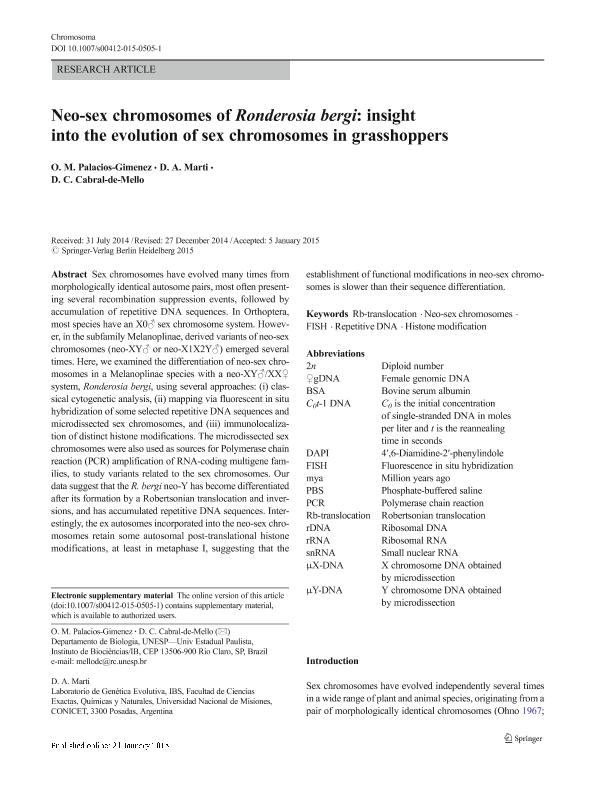Artículo
Neo-sex chromosomes of Ronderosia bergi: insight into the evolution of sex chromosomes in grasshoppers
Fecha de publicación:
09/2015
Editorial:
Springer
Revista:
Chromosoma
ISSN:
0009-5915
Idioma:
Inglés
Tipo de recurso:
Artículo publicado
Clasificación temática:
Resumen
Sex chromosomes have evolved many times from morphologically identical autosome pairs, most often presenting several recombination suppression events, followed by accumulation of repetitive DNA sequences. In Orthoptera, most species have an X0♂ sex chromosome system. However, in the subfamily Melanoplinae, derived variants of neo-sex chromosomes (neo-XY♂ or neo-X1X2Y♂) emerged several times. Here, we examined the differentiation of neo-sex chromosomes in a Melanoplinae species with a neo-XY♂/XX♀ system, Ronderosia bergi, using several approaches: (i) classical cytogenetic analysis, (ii) mapping via fluorescent in situ hybridization of some selected repetitive DNA sequences and microdissected sex chromosomes, and (iii) immunolocalization of distinct histone modifications. The microdissected sex chromosomes were also used as sources for Polymerase chain reaction (PCR) amplification of RNA-coding multigene families, to study variants related to the sex chromosomes. Our data suggest that the R. bergi neo-Y has become differentiated after its formation by a Robertsonian translocation and inversions, and has accumulated repetitive DNA sequences. Interestingly, the ex autosomes incorporated into the neo-sex chromosomes retain some autosomal post-translational histone modifications, at least in metaphase I, suggesting that the establishment of functional modifications in neo-sex chromosomes is slower than their sequence differentiation.
Archivos asociados
Licencia
Identificadores
Colecciones
Articulos(IBS)
Articulos de INSTITUTO DE BIOLOGIA SUBTROPICAL
Articulos de INSTITUTO DE BIOLOGIA SUBTROPICAL
Citación
Palacios Gimenez, O. M.; Marti, Dardo Andrea; Cabral de Mello, D. C.; Neo-sex chromosomes of Ronderosia bergi: insight into the evolution of sex chromosomes in grasshoppers; Springer; Chromosoma; 124; 3; 9-2015; 353-365
Compartir
Altmétricas




